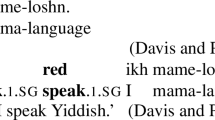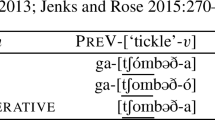Abstract
This article aims to elucidate the true nature of the so-called Double-o Constraint (DoC) in Japanese. The nature of the DoC has long been discussed in the literature since Harada’s work back in the 1970’s, but it has eluded a principled explanation. The DoC has been known to apply to certain domains and a careful study presented in this article shows that these domains correspond to phases. Thus, the DoC reduces to a PF constraint against realizing multiple occurrences of the accusative Case value within a single Spell-Out domain. Specifically, I argue that the DoC applies cyclically phase-by-phase and thus that the DoC provides solid evidence for the cyclic phase-based computation in the current minimalist theorizing (Chomsky 2001, 2004, 2008). If correct, Case in Japanese has two facets: a Case is valued in narrow syntax but its value is only realized at Spell-Out, at which point PF interface conditions apply. It is further suggested that the DoC reduces to a syntactic OCP (Obligatory Contour Principle). The DoC, therefore, is considered to be a case in which an apparently language-particular and hence peripheral phenomenon provides empirical support for the architecture of the Universal Grammar.
Similar content being viewed by others
References
Ackema, Peter. 2001. Colliding complementizers in Dutch: another syntactic OCP. Linguistic Inquiry 32: 717–727.
Baker, Mark. 1988. Incorporation: a theory of grammatical function changing. Chicago: University of Chicago Press.
Boškovíc, Željko. 2002. On multiple Wh-fronting. Linguistic Inquiry 33(3): 351–383.
Browning, Marguerite, and Ezat Karimi. 1994. Scrambling to object position in Persian. In Studies on scrambling: movement & non-movement approaches to free word order phenomena, eds. Norbert Corver and Hank van Reimsdijk, 61–100. Berlin: Mouton de Gruyter.
Chomsky, Noam. 1995. The minimalist program. Cambridge: MIT Press.
Chomsky, Noam. 2000. Minimalist inquiries: The framework. In Step by step: essays on minimalist syntax in honor of Howard Lasnik, eds. Roger Martin, David Michaels, and Juan Uriagereka, 89–155. Cambridge: MIT Press.
Chomsky, Noam. 2001. Derivation by phase. In Ken Hale: a life in language, ed. Michael Kenstowicz, 1–52. Cambridge: MIT Press.
Chomsky, Noam. 2004. Beyond explanatory adequacy. In Vol. 3 of Structures and beyond: the cartography of syntactic structures, ed. Adriana Belletti, 104–131. New York: Oxford University Press.
Chomsky, Noam. 2008. On phases. In Foundational issues in linguistic theory, eds. Robert Freidin, Carlos P. Otero, and Maria Luisa Zubizarreta, 133–166. Cambridge: MIT Press.
Collins, Chris. 1997. Local economy. Cambridge: MIT Press.
Comrie, Bernard. 1976. The grammar of causative constructions. In Syntax and semantics 6: the grammar of causative constructions, ed. Masayoshi Shibatani, 262–312. New York: Academic Press.
Davies, William D. 1986. Choctaw verb agreement and universal grammar. Dordrecht: D. Reidel.
den Dikken, Marcel. 1995. Particles: on the syntax of verb-particle, triadic, and causative constructions. New York: Oxford University Press.
Fukui, Naoki. 2000. Wh-gimonbun no bunseki. In Syntax and meaning: S. I. Harada collected works in linguistics, ed. Naoki Fukui, 817–830. Tokyo: Taishukan.
Grimshaw, Jane, and Armin Mester. 1988. Light verbs and theta-marking. Linguistic Inquiry 19(2): 205–232.
Hale, Ken, and Chisato Kitagawa. 1976–1977. A counter to counter equi. Papers in Japanese Linguistics 5: 41–61.
Harada, S.I. 1973. Counter Equi NP deletion. In Vol. 7 of Annual Bulletin, 113–147. Tokyo: University of Tokyo, Research Institute of Logopedics and Phoniatrics.
Harada, S.I. 1975. The functional uniqueness principle. In Vol. 2 of Attempts in Linguistics and Literature, 17–24. Tokyo: ICU.
Hasegawa, Nobuko. 1985. On the so-called “zero pronouns” in Japanese. The Linguistic Review 4(4): 289–341.
Hiraiwa, Ken. 2002. Facets of case: on the nature of the Double-o Constraint. In The proceedings of the 3rd Tokyo psycholinguistics conference, ed. Yukio Otsu, TCP, 2002, 139–163. Tokyo: Hituzi Shobo.
Hiraiwa, Ken. 2005. Dimensions of symmetry in syntax: agreement and clausal architecture. Unpublished PhD dissertation, MIT.
Hiraiwa, Ken, and Ishihara, Shinichiro. 2002. Missing links: cleft, sluicing and ‘no da’ construction in Japanese. In The proceedings of the HUMIT 2001: MIT working papers in linguistics #43, eds. Tania Ionin, Heejeong Ko, and Andrew Nevins, 35–54. Cambridge: MITWPL.
Hiraiwa, Ken, and Shinichiro Ishihara. 2010. Syntactic metamorphosis: cleft, sluicing, and in-situ focus in Japanese. Syntax (to appear).
Kageyama, Taro. 1993. Bunpoo to gokeisei. Tokyo: Hituzi Shobo.
Kato, Sachiko. 2007. Scrambling and the EPP in Japanese: from the viewpoint of the Kumamoto dialect of Japanese. In The proceedings of FAJL 4, 113–124. Cambridge: MITWPL.
Kim, Jong-Bok, and Peter Sells. 2006. Case assignment in the clause and adjuncts. In The proceedings of the 11th Harvard international symposium on Korean linguistics, 506–519. Cambridge: Harvard University.
Koizumi, Masatoshi. 1995. Phrase structure in minimalist syntax. Unpublished PhD dissertation, MIT.
Kuno, Susumu. 1973. The structure of the Japanese language. Cambridge: MIT Press.
Kuno, Susumu. 1976. Subject raising. In Vol. 5 of Syntax and semantics: Japanese generative grammar, ed. Masayoshi Shibatani, 17–49. New York: Academic Press.
Kurafuji, Takeo. 1997. Case-checking of accusative Wh-adjuncts. In MIT working papers in linguistics #31, 253–272. Cambridge: MITWPL.
Kuroda, S.-Y. 1965. Generative grammatical studies in the Japanese language. PhD dissertation, MIT.
Kuroda, S.-Y. 1978. Case-marking, canonical sentence patterns, and Counter-Equi in Japanese. In Problems in Japanese syntax and semantics, eds. John Hinds and Irwin Howard, 30–51. Tokyo: Kaitakusha.
Kuroda, S.-Y. 1988. Whether we agree or not: a comparative syntax of English and Japanese. Linguisticae Investigationes 12: 1–47.
Kuroda, S.-Y. 1992. Japanese syntax and semantics: collected papers. Dordrecht: Kluwer Academic.
Kuroda, S.-Y. 1999. Syubunaizai kankeisetu. In Gengo no naizai to gaizai, eds. S.-Y. Kuroda and Masaru Nakamura, 27–103. Tokyo: Kurosio.
Kuroda, S.-Y. 1999. Tokoro sesu. In Gengo no naizai to gaizai, eds. S.-Y. Kuroda and Masaru Nakamura, 105–162. Tokyo: Kurosio.
Kuroda, S.-Y. 2000. Gyakkoodouitumeisikusakuztyo oyobi kankeisetuka. In Syntax and meaning: S.I. Harada collected works in linguistics, ed. N. Fukui, 795–803. Tokyo: Taishukan.
Leben, William. 1973. Suprasegmental phonology. Unpublished PhD dissertation, MIT.
Lefebvre, Claire, and Pieter Muysken. 1988. Mixed categories: nominalization in Quechua. Dordrecht: Kluwer Academic.
Maling, Joan, and Soowon Kim. 1992. Case assignment in the inalienable possession construction in Korean. Journal of East Asian Linguistics 1: 37–68.
Marantz, Alec. 1981. Grammatical relations, lexical rules, and Japanese syntax. In Coyote papers 2, 123–144. Tucson: University of Arizona Linguistics Circle.
McCarthy, John. 1986. OCP effects: gemination and antigemination. Linguistic Inquiry 17: 207–263.
Menn, Lise, and Brian MacWhinney. 1984. The repeated morph constraint: toward an explanation. Language 60: 519–541.
Mihara, Ken-ichi. 1994. Nihongo no Toogo Koozoo. Tokyo: Shohakusha.
Miyagawa, Shigeru. 1989. Syntax and semantics 22: structure and case marking in Japanese. New York: Academic Press.
Miyagawa, Shigeru. 1997. Against optional scrambling. Linguistic Inquiry 28(1): 1–25.
Miyagawa, Shigeru. 1999. Causatives. In The handbook of Japanese linguistics, ed. Natsuko Tsujimura, 236–268. Malden: Blackwell.
Miyake, Tomohiro. 1996. Nihongo no idoodoosi no taikakuhyoozi nituite (On accusative case-marking in motion verbs in Japanese). Gengokenkyu 110: 143–168.
Mohanan, Tara. 1994. Case OCP: a constraint on word order in Hindi. In Theoretical perspectives on word order in South Asian languages, eds. Miriam Butt, Tracy Holloway King, and Gillian Ramchand, 185–216. Stanford: CSLI.
Murasugi, Keiko. 2000. Japanese complex noun phrases and the antisymmetry theory. In Step by step: essays on minimalist syntax in honor of Howard Lasnik, eds. Roger Martin, David Michaels, and Juan Uriagereka, 211–234. Cambridge: MIT Press.
Neeleman, Ad, and Hans Van de Koot. 2006. Syntactic haplology. In Vol. 4 of The Blackwell companion to syntax, eds. Martin Everaert, Henk van Riemsdijk, Rob Goedemans, and Bart Hollebrandse, 685–710. New York: Blackwell.
Nishigauchi, Taisuke. 1998. Multiple sluicing in Japanese and the functional nature of wh-phrases. Journal of East Asian Linguistics 7(2): 121–152.
Nishiyama, Kunio, John Whitman, and Eun-Young Yi. 1995. Syntactic movement of overt Wh-phrases in Japanese and Korean. In Japanese/Korean Linguistics 5, 337–351. Stanford: CSLI.
Nissenbaum, Jon. 2001. The investigations of covert phrasal movement. Unpublished PhD dissertation, MIT.
Odden, David. 1986. On the role of the Obligatory Contour Principle in phonological theory. Language 62: 353–383.
Poser, William J. 1981. The “Double-o Constraint”: evidence for a direct object relation in Japanese. Manuscript, MIT.
Poser, William J. 2002. The Double-O Constraints in Japanese. Manuscript, University of Pennsylvania.
Richards, Norvin. 2006. A distinctness condition on linearization. Manuscript, MIT.
Saito, Mamoru. 1982. Case marking in Japanese: A preliminary study. Manuscript, MIT.
Saito, Mamoru. 1985. Some asymmetries in Japanese and their theoretical implications. Unpublished PhD dissertation, MIT.
Saito, Mamoru. 1989. Scrambling as semantically vacuous A′-movement. In Alternative conceptions of phrase structure, eds. Mark Baltin and Anthony Kroch, 182–200. Chicago: University of Chicago Press.
Saito, Mamoru. 1992. Long distance scrambling in Japanese. Journal of East Asian Linguistics 1(1): 69–118.
Saito, Mamoru, and Hiroto Hoshi. 2000. The Japanese light verb construction and the minimalist program. In Step by step: in honor of Howard Lasnik, eds. Roger Martin, David Michaels, and Juan Uriagereka, 261–296. Cambridge: MIT Press.
Sasaki, Kan. 2004. Mitsukaido hoogen ni okeru kaku to bunpoo kankei [The case and grammatical relation in the Mitsukaido dialect]. Tokyo: Kurosio.
Sasaki, Takashi. 2007. Mokutekigo-o saisetusuru: Joodaigo-no koobun. Kokugokokubun 76(10): 40–54.
Shibatani, Masayoshi. 1973. Semantics of Japanese causativization. Foundations of Language 9: 327–373.
Shibatani, Masayoshi. 1978. Nihongo no bunseki. Tokyo: Taishukan.
Takahashi, Daiko. 1994. Sluicing in Japanese. Journal of East Asian Linguistics 3(3): 265–300.
Takano, Yuji. 2002. Surprising constituents. Journal of East Asian Linguistics 11(3): 243–301.
Tsubomoto, Atsuro. 1998. Bunrenketsu no katachi to imi to goyooron. In Modality to Hatsuwakooi, ed. Minoru Nakau, 100–193. Tokyo: Kenkyusha.
Tsujimura, Natsuko. 1996. Introduction to Japanese linguistics. New York: Blackwell.
Ura, Hiroyuki. 1996. Multiple feature-checking: a theory of grammatical function splitting. Unpublished PhD dissertation, MIT.
Ura, Hiroyuki. 2000. Checking theory and grammatical functions in universal grammar. New York: Oxford University Press.
Uriagereka, Juan. 1999. Multiple spell-out. In Working minimalism, eds. Samuel D. Epstein and Norbert Hornstein, 251–282. Cambridge: MIT Press.
van Riemsdijk, Henk. 1988. The representation of syntactic categories. In Proceedings of the conference on the Basque language, 2nd Basque World Congress, 104–116. Victoria-Gasteiz: Central Publication Service of the Basque Government.
van Riemsdijk, Henk. 1998. Syntactic feature magnetism: the endocentricity and distribution of projections. Journal of Comparative Germanic Linguistics 2: 1–48.
Watanabe, Akira. 1991. Wh-in-situ, subjacency, and chain formation. MIT occasional papers linguistics 2. Cambridge: MITWPL.
Watanabe, Akira. 1992. Subjacency and s-structure movement of Wh-in-situ. Journal of East Asian Linguistis 1(3): 255–299.
Watanabe, Akira. 1996. Case absorption and Wh-agreement. Dordrecht: Kluwer Academic.
Williams, Edwin. 1981. Argument structure and morphology. The Linguistic Review 1(1): 81–114.
Yip, Moria. 1998. Identity avoidance in phonology and morphology. In Morphology and its relation to phonology and syntax, eds. Steven G. Lapointe, Diane K. Brentari, and Patrick M. Farrell, 216–246. Stanford: CSLI.
Yoshimura, Noriko. 1994. “ga” no mondai. In Hen’yoo-suru gengobunka kenkyuu, 13–28. Shizuoka: Shizuoka Prefectural University.
Author information
Authors and Affiliations
Corresponding author
Additional information
I am very grateful to three anonymous reviewers for NLLT. This material has been presented at various places including Kwansei Gakuin University, The University of British Columbia, The University of Calgary, The University of The Ryukyus, and The University of Washington. I would also like to thank the Japanese native speakers in the audience for their judgments. I am grateful to Noam Chomsky, Marcel den Dikken, Yoshi Dobashi, Tomo Fujii, Naoki Fukui, Takeo Kurafuji, Shinsho Miyara, Kimiko Nakanishi, David Pesetsky, Hiroyuki Ura, and Akira Watanabe. Special thanks to Marcel den Dikken for editorial assistance and to Adam Steffanick for proof-reading the manuscript. All errors and are solely mine. This work is partially supported by the Grant-in-Aid for JSPS Fellows No. 1710271 from the Ministry of Education, Sports, and Culture. The abbreviations used in this article are as follows: Acc = Accusative, Ben = Benefactive, Caus = Causative, C = Complementizer, Cl = Classifier, Cop = Copula, Dat = Dative, Dem = Demonstrative, F = Focus marker, Gen = Genitive, Loc = Locative, Lv = Light verb, Nml = Nominalizer, Nom = Nominative, Pass = Passive, Pl = Plural, Pres = Present, Prog = Progressive, Pst = Past, Q = Q-complementizer, Sg = Singular, Top = Topic marker.
Rights and permissions
About this article
Cite this article
Hiraiwa, K. Spelling out the Double-o Constraint. Nat Lang Linguist Theory 28, 723–770 (2010). https://doi.org/10.1007/s11049-010-9098-9
Received:
Accepted:
Published:
Issue Date:
DOI: https://doi.org/10.1007/s11049-010-9098-9




